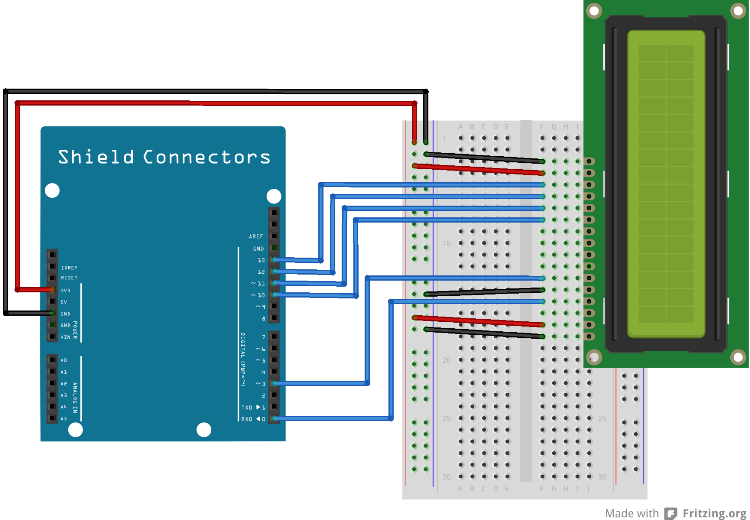LPC812 MAX Experiment: Character LCD
Experiment: Character LCD
In this experiment you will learn how to control a character LCD display. The display is a LMB162AFC-2 from TOPWAY and the manual for it can be found here.
Hardware
In this lab you will need:
- 1x breadboard
- 1x character LCD
- cables
Mount the components on the breadboard and connect the breadboard to the LPC812 as show in the image below.

The pin(s) are specified in the mbed library with the actual pin names as well as some useful aliases:
| Schematic Name | mbed Pin Name | Arduino Shield Alias | Description |
|---|---|---|---|
| PIO0_0 | P0_0 | D0 | RS - Register Select |
| PIO0_4 | P0_4 | D1 | R/W - Read / Write Control Bus |
| PIO0_8 | P0_8 | D3 | E - Data Enable |
| PIO0_13 | P0_13 | D10 | DB4 |
| PIO0_14 | P0_14 | D11 | DB5 |
| PIO0_15 | P0_15 | D12 | DB6 |
| PIO0_12 | P0_12 | D13 | DB7 |
As the display will be used in 4 bit mode, the DB0 to DB3 pins are left unconnected.
Description
There is an mbed library that supports our character LCD:
Import library
Public Types |
|
| enum |
LCDType
{
LCD8x1 , LCD8x2 , LCD8x2B , LCD12x2 , LCD12x4 , LCD16x1 , LCD16x2 , LCD16x2B , LCD16x4 , LCD20x2 , LCD20x4 , LCD24x2 , LCD24x4 , LCD40x2 , LCD40x4 } |
|
LCD panel format. More... |
|
| enum | LCDCtrl { HD44780 , WS0010 , ST7036 } |
|
LCD Controller Device. More... |
|
| enum | LCDCursor { CurOff_BlkOff = 0x00, CurOn_BlkOff = 0x02, CurOff_BlkOn = 0x01, CurOn_BlkOn = 0x03 } |
|
LCD Cursor control. More... |
|
| enum | LCDMode { DispOff = 0x00, DispOn = 0x04 } |
|
LCD Display control. More... |
|
| enum | LCDBacklight { LightOff , LightOn } |
|
LCD Backlight control. More... |
|
Public Member Functions |
|
| TextLCD (PinName rs, PinName e, PinName d4, PinName d5, PinName d6, PinName d7, LCDType type=LCD16x2, PinName bl=NC, PinName e2=NC, LCDCtrl ctrl=HD44780) | |
|
Create a
TextLCD
interface for using regular mbed pins.
|
|
| TextLCD (I2C *i2c, char deviceAddress, LCDType type=LCD16x2, LCDCtrl ctrl=HD44780) | |
|
Create a
TextLCD
interface using an I2C PC8574 portexpander.
|
|
| TextLCD (SPI *spi, PinName cs, LCDType type=LCD16x2, LCDCtrl ctrl=HD44780) | |
|
Create a
TextLCD
interface using an SPI 74595 portexpander.
|
|
| int | putc (int c) |
|
Write a character to the LCD.
|
|
| int | printf (const char *format,...) |
|
Write a formated string to the LCD.
|
|
| void | locate (int column, int row) |
|
Locate to a screen column and row.
|
|
| int | getAddress (int column, int row) |
|
Return the memoryaddress of screen column and row location.
|
|
| void | setAddress (int column, int row) |
|
Set the memoryaddress of screen column and row location.
|
|
| void | cls () |
|
Clear the screen and locate to 0,0.
|
|
| int | rows () |
|
Return the number of rows.
|
|
| int | columns () |
|
Return the number of columns.
|
|
| void | setCursor ( LCDCursor cursorMode) |
|
Set the Cursormode.
|
|
| void | setMode ( TextLCD::LCDMode displayMode) |
|
Set the Displaymode.
|
|
| void | setBacklight ( TextLCD::LCDBacklight backlightMode) |
|
Set the Backlight mode.
|
|
| void | setUDC (unsigned char c, char *udc_data) |
|
Set User Defined Characters.
|
|
The library is described in detail here.
Start with this basic program:
main.cpp
#include "mbed.h"
#include "TextLCD.h"
Serial pc(USBTX, USBRX); // tx, rx
TextLCD lcd(D0, D3, D10, D11, D12, D13, TextLCD::LCD16x2); // rs, e, d4-d7
int main()
{
pc.printf("LCD Test. Columns=%d, Rows=%d\n\r", lcd.columns(), lcd.rows());
// Clear screen
lcd.cls();
lcd.printf("Hello\nWorld!");
wait(3);
// Example using putc() which automatically moves the cursor
lcd.cls();
for (char c = '0'; c <= 'Z' ; c++)
{
lcd.putc(c);
wait(0.3);
}
while(1)
;
}
Test the different functions in the TextLCD library and get to know how the cursor works and how to handle cls() and locate().
If you have a GPS module, go back to the GPS experiment and print the latitude and longitude information on the display instead of the terminal.
Solution(s)
Import programlpc812_exp_solution_character-lcd
Solutions for the Character LCD experiments for LPC812 MAX
1 comment on LPC812 MAX Experiment: Character LCD:
Please log in to post comments.

Hi guys,
Once I am trying to compile the program, I am receiving some of the following error messages:
Error: No space in execution regions with .ANY selector matching ctype_c.o(.constdata). Error: No space in execution regions with .ANY selector matching TextLCD.cpp.LPC812.o(i._ZN7TextLCDD1Ev). Error: No space in execution regions with .ANY selector matching FileLike.o(.constdataZTVN4mbed8FileLikeE). Error: No space in execution regions with .ANY selector matching FileBase.o(i._ZN4mbed8FileBaseD1Ev). Error: No space in execution regions with .ANY selector matching Serial.o(i._ZN4mbed6SerialC1E7PinNameS1_PKc). . . . .
Error: Sections of aggregate size 0xac4 bytes could not fit into .ANY selector(s).
I am using LPC812 Max Board. I suppose it is because of the RAM. This LPC has only 4KB.
Any clues?
Thanks,
Filip